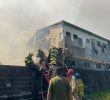DAVAO CITY, Philippines – The hills which the faithful associate with the saints needed to be protected, they said. The message was more than a prayer. It was a petition to the government. The year was 2006. At the time, to talk about matters related to climate change was barely taken seriously.
More than a decade later on October 5, 2017, the earth fell. Authorities called it a “minor” landslide. But the morning after the incident, thousands of commuters and motorists faced an ordeal that would continue for days. A portion of Diversion Road was closed. Above, loose earth continued to crumble.
And there were families, some 40 of them, who needed to find safer grounds. Their homes were within “highly dangerous zones.” Davao had been experiencing torrential rains last week. The downpour could be fatal.
The reason, Arnold Vandenbroeck said, was that the Shrine Hills is indeed prone to landslides.
“Who cares?” he wrote in a Facebook post, seemingly to scoff at inaction even after his group Save Davao Shrine Hills has had a strong basis to lobby government against permitting further developments at the area.
Save Davao Shrine Hills was formed in 2006, when communities at the area experienced flash floods. Since then, they signed petitions asking government to turn Shrine Hills into a protected area.
In 2007, the Mines and Geo-sciences Bureau (MGB) stood in favor of the group’s call when it declared the area as landslide-prone. Development on Shrine Hill’s slopes for high-end subdivisions continued, and urban poor group Kalipunan ng Damayang Mahihirap worried of an environmental destruction.
In 2011, the MGB released a geohazard study, saying that there should be no human intervention and development on its slopes as they are unstable. The results were presented to the City Council in the same year, said state geologist Beverly Brebante on Tuesday, October 10. It was only in 2013 that the City Council designated Shrine Hills as a protected zone.
If the warnings have been told years ago, who missed the message?
‘New’ zoning ordinance
Although the message was clear, there were “new” concepts that were difficult to understand, according to Acting Zoning Administrator Roy Rigor.
One of those, he said, was the Urban Ecological Sub-zone classification under the Comprehensive Zoning Ordinance of 2013.
So Shrine Hills, even if it has been reclassified as Urban Ecological Sub-zone, was still perceived to be a residential subzone, given the presence of developments scattered around the area, including a resort, residential subdivisions, and broadcasting stations.
“There were already property owners there who developed the area for commercial purposes,” Rigor told Davao Today on Wednesday, October 11.
One of the possible causes of the landslide on October 5 was the tension cracks found within the Seventh Day Adventist church’s retreat house and adjacent properties, according to Brebante. The same property houses a radio station
The findings were the result of their ocular inspection at the Shrine Hills on September 30 with the City Disaster Risk Reduction and Management Council.
It added that there had been movements in the landslide-affected area and could be “attributed to the weakening of the slope material and undercutting of the base slopes.”
Brebante added that the “presence of spring may have contributed to the weakening of the slope due to saturation of the soil.” However, she said the spring “was already present prior to road activities.”
Building permit violations
On Monday, October 9, City Engineer Joseph Dominic Felizarta hinted that a radio station and an owner of a residential property had been issued notices of violation for failure to comply with a building permit.
Rigor said they already filed charges on August 23 against one property owner and are gathering evidence to file cases against four more property owners. A case was also filed in June this year against another property owner.
City Planning and Development Officer Ivan Cortez, meanwhile said they have not issued clearances since 2013 as the area was declared prone to landslide.
Government projects
Brebante also pointed out to another cause of the landslide: a road-widening project carried out by the DPWH which “may have weakened the stability on the area.”
Another joint ocular inspection was conducted on October 6 by the MGB with the City Engineer’s Office and the DPWH. In its findings, it noted that the “slope failure on the area may also be aggravated by the almost vertical slope as a result of the road cut.”
The DPWH currently has two road widening projects worth P246.7 million located in the Maa-Carlos P. Garcia Highway. One is a 0.6-kilometer road widening project amounting to P107.9 million and a one-kilometer road widening project worth P138.8 million.
DPWH geologist Thea Peguit explained that prior to the implementation of the project the agency has secured an Environmental Compliance Certificate (ECC) from the Department of Environment and Natural Resources (DENR)
Peguit, during the regular session at the City Council on Tuesday, October 10, explained they have been coordinating with the MGB since last year. She said the portion where the landslide occurred was “already an old landslide,” called an “escarpment.”
“It’s already weak and made up of unconsolidated materials,” Peguit said. She also mentioned a diversion of waterway that has caused additional weight to the land.
“Our project may be one of the (contributory causes), but the main cause is the development at the upper side,” Peguit said, referring to the ongoing constructions on top of the Shrine Hills.
DPWH 11 spokesperson Dean Ortiz also said they have secured “certificate of no objection” from Barangay Matina Pangi and Barangay Langub before they proceeded with the project.
The DPWH projects started in April and May this year and are expected for completion by March 2018.
Ortiz said “the cracks were already in the upper portion prior to the implementation of the projects.”
Lack of coordination
The real estate owner’s failure to comply with a building permit and DPWH’s project implementation could be a case of a lack of coordination.
In an interview, City Planning and Development Officer Ivan Cortez said the DPWH, for one, did not inform the local government unit of the project.
“Partly, they are to be blamed,” he said.
In an August 10 letter, Cortez said they wrote DPWH asking for an explanation why they started the project and what their mitigating factors were as the area has been identified as a landslide-prone area.
Cortez said that the DPWH has not put in place protection measures, despite indicating in a letter that they would.
Powerless LGU?
The landslide could have been avoided had there been proper planning been put in place, according to Vandenbroeck, who cited the Implementing Rules and Regulations (IRR) of the city’s Zoning Ordinance,
The IRR, he said, could provide guidelines for the enforcement of the ordinance that declared 222 hectares of Shrine Hills as an “urban ecological enhancement sub-zone.”
Article 9 Section 3 of the ordinance states that urban ecological enhancement subzones to which some areas of Shrine Hills is part of are intended for “massive greening program.”
The areas are also declared protected at all times and only limited activities are allowed, including improvement and maintenance of waterways, reforestation development projects, and other greening programs. The Zoning Ordinance was passed in 2013, but its IRR is yet to be approved.
Lack of foresight
The message in 2006 was loud and clear, but to respond to it is another story.
What we know for now is that efforts are being done so the city recovers from the landslide that preluded a monstrous traffic which the business community said have taken a toll on the local economy.
The DPWH said the clearing process at the landslide-affected area could extend for up to five days more. The city government has deployed buses for passengers who may be stranded “because of the current traffic situation.”
But Vandenbroeck wishes this is not the kind of reality the public now faces.
With some foresight, he said, “a lot could have been done a few years ago.” (davaotoday.com)










